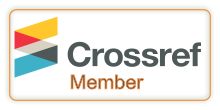THE BLIND SIDE OF A RAIN GAUGES NETWORK: INTRODUCTORY THEORETICAL APPROACH, WITH A FIRST EXAMPLE OF APPLICATION.
DOI:
https://doi.org/10.29121/granthaalayah.v13.i5.2025.6152Keywords:
Rain Gauges, Network, Undetected Events, Isolated Events, Rainfall Depth, Rain VolumeAbstract [English]
One of the shortcomings implicit in the use of a network of rain gauges is to detect weather phenomena in pre-established geographical points that are stable over time. A discrete and finite number of measurement points are arranged to capture values of precipitation variables of atmospheric events.
It happens that several of these precipitation events can impact areas that do not include any measurement point. This phenomenon reveals a blind side of the network: the hydrological values associated with such events are irreversibly and completely lost from the network.
In this paper, a theoretical model suitable for estimating such events not captured by the network is described and proposed at an introductory level; introducing useful equations for estimating values such as: number of events, rainfall depths, rain volumes inferable on the ground.
Starting from the hypothesis of isotropy and local homogeneity of some key variables, number of events and rainfall depth, we arrive at the synthesis of some significant relationships between the precipitation values of extremely isolated events completely not captured by the network, those measured by the network and the clusters of atmospheric events that generated both.
The method allows these results to be obtained by making use only of the rainfall data provided by a network of rain gauges. The denser the network, the smaller the extent of such non-captured events; the more frequent the network measurement time is, the shorter the potentially deductible duration of such events.
A first example of application shows that for a fairly dense network the estimated average annual rainfall not measured by a rain gauge can reach a value corresponding to 80% of the average annual total rainfall measured by the rain gauge itself. The results are confirmed by the literature. It must be taken into account that when calculating the volumes associated with this percentage lost, mainly small impact areas must be considered. In fact, the distribution of impact areas estimated for this application seems to favour smaller ones.
Downloads
References
Abu Salleh, N. S., Mohd Aziz, M. K. B., & Adzhar, N. (2019). Optimal Design of A Rain Gauge Network Models: Review Paper. Journal of Physics: Conference Series, 1366(1), 012072. https://doi.org/10.1088/1742-6596/1366/1/012072 DOI: https://doi.org/10.1088/1742-6596/1366/1/012072
Bedient, P. B., Huber, W. C., & Vieux, B. E. (2019). Hydrology and Floodplain Analysis (6th ed.). Pearson.
Dai, Q., Bray, M., Zhuo, L., Islam, T., & Han, D. (2017). A Scheme for Rain Gauge Network Design Based on Remotely Sensed Rainfall Measurements. Journal of Hydrometeorology, 18(3), 363–379. https://doi.org/10.1175/JHM-D-16-0136.1 DOI: https://doi.org/10.1175/JHM-D-16-0136.1
Dervos, N. A., & Baltas, E. (2024). Development of Experimental Low-Cost Rain Gauges and Their Evaluation During A High-Intensity Storm Event. Environmental Processes. https://doi.org/10.1007/s40710-024-00686-7 DOI: https://doi.org/10.1007/s40710-024-00686-7
Klain, D. A., & Rota, G. C. (1997). Introduction to Geometric Probability. Cambridge University Press.
Landau, L. D., & Lifshitz, E. M. (1982). Course of theoretical physics: Vol. 1: Mechanics.
Lengfeld, K., Becker, A., Kirstetter, P.-E., Fowler, H. J., Yu, J., Flamig, Z., & Gourley, J. (2020). Use of Radar Data for Characterizing Extreme Precipitation At Fine Scales and Short Durations. Environmental Research Letters, 15(8), 10. https://doi.org/10.1088/1748-9326/ab98b4 DOI: https://doi.org/10.1088/1748-9326/ab98b4
Lim, S. (2020). A Novel Electromagnetic Wave Rain Gauge and Its Average Rainfall Estimation Method. Remote Sensing, 12(21), 3528. https://doi.org/10.3390/rs12213528 DOI: https://doi.org/10.3390/rs12213528
Mathai, M. (1999). An Introduction To Geometrical Probability: Distributional Aspects With Applications. Statistical Distributions & Models with Applications: Vol.1.
Ochoa‐Rodriguez, S., Wang, L.-P., Willems, P., & Onof, C. (2019). A Review of Radar‐Rain Gauge Data Merging Methods and Their Potential for Urban Hydrological Applications. Water Resources Research, 55, 6356–6391. https://doi.org/10.1029/2018WR023332 DOI: https://doi.org/10.1029/2018WR023332
Segovia-Cardozo, D. A., Bernal-Basurco, C., & Rodríguez-Sinobas, L. (2023). Tipping Bucket Rain Gauges in Hydrological Research: Summary on Measurement Uncertainties, Calibration, and Error Reduction Strategies. Sensors, 23, 5385. https://doi.org/10.3390/s23125385 DOI: https://doi.org/10.3390/s23125385
Segovia-Cardozo, D. A., Rodríguez-Sinobas, L., Díez-Herrero, A., Zubelzu, S., & Canales-Ide, F. (2021). Understanding the Mechanical Biases of Tipping-Bucket Rain Gauges: A Semi-Analytical Calibration Approach. Water, 13(16), 2285. https://doi.org/10.3390/w13162285 DOI: https://doi.org/10.3390/w13162285
Sokol, Z., Szturc, J., Orellana-Alvear, J., Popová, J., Jurczyk, A., & Célleri, R. (2021). The Role of Weather Radar in Rainfall Estimation and its Application in Meteorological and Hydrological Modelling—A Review. Remote Sensing, 13(3), 351. https://doi.org/10.3390/rs13030351 DOI: https://doi.org/10.3390/rs13030351
Tardivo, G., Bixio, V., & Bixio, A. C. (2022). A New Method of Identifying An Appropriate Distance Between Independent Extreme Annual Rain Events for a 5-min time Resolution Precipitation Data Network. Theoretical and Applied Climatology, 149, 169–183. https://doi.org/10.1007/s00704-022-04043-2 DOI: https://doi.org/10.1007/s00704-022-04043-2
Villarini, G., Mandapaka, P. V., Krajewski, W. F., & Moore, R. J. (2008). Rainfall and Sampling Uncertainties: A Rain Gauge Perspective. Journal of Geophysical Research, 113, D11102. https://doi.org/10.1029/2007JD009214 DOI: https://doi.org/10.1029/2007JD009214
Yoon, S. S., Phuong, A. T., & Bae, D. H. (2012). Quantitative Comparison of the Spatial Distribution of Radar and Gauge Rainfall Data. Journal of Hydrometeorology, 13(6), 1939–1953. https://doi.org/10.1175/JHM-D-11-066.1 DOI: https://doi.org/10.1175/JHM-D-11-066.1
Published
How to Cite
Issue
Section
License
Copyright (c) 2025 Gianmarco Tardivo

This work is licensed under a Creative Commons Attribution 4.0 International License.
With the licence CC-BY, authors retain the copyright, allowing anyone to download, reuse, re-print, modify, distribute, and/or copy their contribution. The work must be properly attributed to its author.
It is not necessary to ask for further permission from the author or journal board.
This journal provides immediate open access to its content on the principle that making research freely available to the public supports a greater global exchange of knowledge.






























